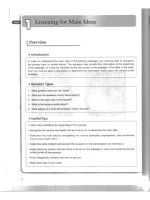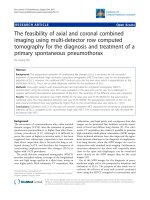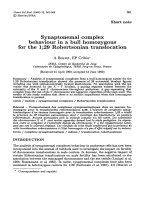Optical alignment sensitivities for the 1.6-m NST off axis primary mirror
Bạn đang xem bản rút gọn của tài liệu. Xem và tải ngay bản đầy đủ của tài liệu tại đây (295.09 KB, 5 trang )
Optical alignment sensitivities for the
1.6-m NST off axis primary mirror
October 7, 2003
Jim Burge
University of Arizona
The polishing, testing, and support systems for the off axis primary mirror for the NST
(New Solar Telescope) are currently being developed. This memo defines the geometry for the
primary mirror and presents sensitivities to alignment.
1
Definition of the optical surface
The nominal prescription of the mirror is given below in Table 1. These data are taken
from SPIE5171-47. The telescope is specified to have a 1.6-m clear aperture. The primary is
off axis and tilted relative to the incoming light. This causes the circular telescope pupil to map
to a 1.6 m x 1.65 elliptical pupil on the mirror, as vied from its center of curvature.
The definition for the off axis geometry is shown in Figure 1.
Table 1. Specifications for the off-axis mirror
Parameter
Nominal value
Vertex Radius of Curvature
Conic Constant
Diameter of mirror blank
Clear aperture of mirror in telescope
Distance between mirror center and parent vertex
7.700 meters
-1.00
1.7 meters
1.6 meters
1.84 meters
1
Figure 1. Definition of geometry for the off axis mirror. This is shown
as a projection in the direction of the optical axis of the parent.
1.1
Aspheric departure
The shape of the aspheric optical surface is defined in the coordinates of the parent
mirror. The optical shape follows the equation:
z(r ) =
Where
r2
R + R 2 − ( K + 1)r 2
z(r) = surface height
r = radial position (r2 = x2 + y2) in parent coordinates
R = vertex radius of curvature
K = conic constant ( K = -e2 where e is eccentricity).
It is useful to evaluate the aspheric departure of surface for the optical test. The
dominant term for this aspheric departure for the complete 5.28 meter diameter parent is about
3.3mm P-V or 1 mm rms spherical aberration, adjusted to the best fit sphere. This can be
2
approximated for the off axis part as a combination of low order Zernike polynomials, centered
on the circular aperture of the mirror. The coefficients are given below in Table 2 and a plot of
the aspheric departure is shown in Figure 2. When adjusted to the best fit power and tilt, the
surface has about 2600 µm P-V, and 470 µm rms aspheric departure.
Table 2. Aspheric departure in part-centered coordinates
Parameter
Zernike coefficient in
µm
Astigmatism
Coma
Spherical aberration
Trefoil
Residual higher order
1120
324
-18.6
0.8
µm rms
457
114
8
0.3
0.06
Figure 2. Aspheric departure of the off axis mirror in units of microns. The parent
axis would be above the plot.. The color scale is shown in units of micrometers.
3
2
Sensitivities to alignment and fabrication
A model of the mirror, as viewd from its center of curvature, was developed and
perturbed to investigate the sensitivities. The results below are evaluated over the 1.6-m
circular telescope pupil, (which gives a 1.65 x 1.6 m elliptical beamprint on the mirror surface.
Table 3. Relationship between geometric tolerances and equivalent shape error
Parameter
Value
Perturbation
Equivalent shape error
Conic constant
-1.00
0.0001
42 nm rms with same shape as
shown in Fig. 2
1.84 m
1 mm
0.43 µm rms, shown in Fig. 3.
1 mrad
0.9 µm rms, shown in Fig. 4.
Off axis distance
Clocking
The shape errors corresponding to a 1 mm radial shift, and 1 mrad clocking are given
below in Figures 3 and 4.
Figure 3. Change in surface equivalent with 1 mm
radial shift, showing 2.2 µm P-V, or 0.43 µm rms.
Figure 4. Change in surface equivalent with 1 mrad
clocking error showing 4.7 µm P-V. This gives 0.9 µm
rms surface error after removing tilt and power.
4
I also investigate the effect of a 0.0001 scale error for the aspheric correction.. This causes
surface errors of 0.54 µm P-V or 0.1 µm rms (after removing power)
Table 4. Effect of perturbations on mirror surface for low order modes. The values in the table
are in µm rms, surface.
pertur astig
coma
SA
trefoil
residual
b
Aspheric
456
114
8.3
0.3
0.056
departure
.0001
0.041
0.01
0
0
0
Κ = 1.000
Offset = 1840 mm
Clocking (mrad)
Test optics scale
1
1
0.0001
0.440
0.91
0.091
0.041
0.11
0.034
0.002
0
0.003
0.009
0.009
0.001
0.002
0.002
<0.001
5









